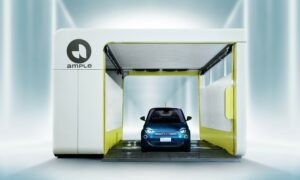
Stellantis partners with Ample on new EV battery swap initiative
By onMarket Trends | Technology
Stellantis has partnered with a modular battery swapping company on an electric vehicle (EV) solution that it says would allow drivers to replace their depleted batteries for new ones within five minutes.
Its work with Ample will begin next year in Europe with Free2move’s car-sharing Fiat 500e fleet, Stellantis said.
The companies are also in discussions about expanding Ample’s technology to meet Stellantis’ fleet and customer demand across other platforms and geographies, Stellantis said in a press release.
The automaker added that beyond its immediate plans, the technology has the potential to address concerns like the length of time it takes to charge a battery. It’s worth noting that swapping out a battery wouldn’t be any easier than refilling a gas tank. In fact, it might prove a bit more challenging, depending on how difficult it is to find an Ample station, drive there, and possibly wait in line for a turn to be served.
However, Stellantis said the intent is to make the process of driving an EV easier.
“Ample batteries are designed to be a drop-in replacement for an electric vehicle’s original battery,” Stellantis said in a press release announcing the initiative. “This is made possible by Ample’s modular batteries, which can fit into any electric vehicle, and would allow Stellantis to integrate Ample’s technology without reengineering its vehicle platforms.”
It added that when an EV driver is ready to swap out their battery, they can do so by driving to an Ample station. After pulling into the garage, they can order a battery swap on a mobile app and be back on the road in less than five minutes, Stellantis said.
EV charging time and range have been among the top concerns among drivers.
Survey results released by AAA last month indicate more than half of respondents aren’t convinced EVs are worth purchasing when battery range and cost are considered. S&P Global Mobility found nearly half of global respondents to its similar survey consider EV prices to be too high.
AAA found that 1 in 4 U.S adults would be “very likely” or “likely” to buy an EV the next time they buy a vehicle. However, cost (59%), lack of charging stations (56%), cost to replace or repair the battery (55%), and range anxiety (53%) remain the primary barriers to purchasing an EV for those undecided or unlikely to buy an EV.
Khaled Hassounah, CEO of Ample, said his company’s technology is working to alleviate such concerns.
“At Ample, we believe in the importance of making electric vehicles accessible to everyone without compromises, which is the only way that we will make a significant impact on lowering greenhouse gas emissions,” Hassounah said. “The combination of offering compelling electric vehicles that can also receive a full charge in less than five minutes will help remove the remaining impediments to electric vehicle adoption.
“We look forward to working with Stellantis to deploy our joint solution across communities around the world.”
Efforts are underway among other OEMs to expedite charging times as well, including the installation of Mercedes’ first high-power charging stations.
In October, the first Mercedes-Benz Charging Hubs went into operation in Atlanta, Georgia; Chengdu, China, and Mannheim, Germany. By the end of 2024, the automaker plans to expand its global charging network to more than 2,000 high-power charging points.
The long-term goal is to create more than 2,000 Charging Hubs with more than 10,000 charging points by the end of the decade.
Depending on region, the charging stations offer charging rates up to 400 kilowatts (kW) provided via Combined Charging Standard Combo 1 (CCS1), Combined Charging Standard Combo 2 (CCS2), North American Charging Standard (NACS), and China’s GB/T standard. Each vehicle can be charged at its maximum power rating, which Mercedes says reduces charging time for customers to “an absolute minimum.”
Meanwhile, Ford announced last week that it is working with Resideo, a home automation solutions company, on how EVs and homes can share the same battery source and interact with each other.
The news follows a previous announcement in September that BMW, Ford, and Honda would work together to create a new company called ChargeScape that will create a single platform for connecting electric utilities and automakers with EV drivers.
The OEMs said in a joint press release at the time that they’re partnering on the initiative to share their collective research on the Open Vehicle-Grid Integration Platform (OVGIP). ChargeScape is intended to support grid resiliency through energy management.
Ford said its project with Resideo will simulate the integration of Resideo’s smart thermostats with the energy stored in the battery on the F-150 Lightning, which can be smartly coordinated to help power the home’s heating and cooling systems.
The project is designed to assess how the coordination of a bidirectional EV and a smart thermostat can reduce the overall energy needed by the home during times of electric grid stress.
“Driving electric is unlocking an entirely new world of personal energy management that could not only save our customers time and money but also help support a more sustainable energy grid,” said Bill Crider, Ford’s head of global charging and energy services. “Successful vehicle-to-home energy management solutions would give Ford EV drivers as well as utilities and power companies the confidence to accelerate future vehicle-to-grid services never-before thought possible with traditional vehicles.”
Images
Featured image courtesy of Stellantis
